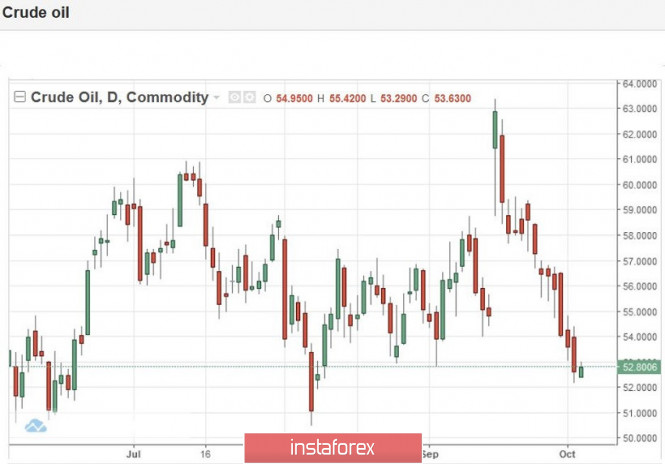Despite the general weakening of the US currency, the USD/CAD pair jumped more than 100 points yesterday, reaching 1.3324 and thereby updating the monthly high. The Canadian dollar fell in price not only against the greenback, but also in cross pairs, for example, against market outsiders such as the Australian dollar and New Zealand dollar. This vulnerability of the loonie is explained by the downward dynamics of the oil market, amid a slowdown in the growth of the national economy. The combination of unipolar fundamental factors helped the USD/CAD bulls provoke an upward impulse, after which the pair consolidated within the 33rd figure.

Data on Canadian GDP growth, which was published on October 1, only confirmed the fears of many analysts regarding the further actions of the Canadian central bank. The indicator came out in the "red zone", not justifying the forecasts of most analysts: on a monthly basis, the indicator was at zero level (with a weak forecast of growth to 0.1%), while in annual terms it dropped to 1.3% (with the forecast growth up to 1.4%). Such weak dynamics discouraged USD/CAD traders, since macroeconomic reports from Canada have recently been controversial, putting pressure on the loonie.
Let me remind you that following the September meeting of the Bank of Canada, Stephen Poloz, contrary to numerous rumors, did not announce the interest rate cut, and indeed left this question in the air. According to him, everything will depend on the dynamics of the development of the trade war, as well as on incoming data. The prospects for resolving the global conflict look vague - the financial world is waiting for the October meeting of the representatives of Beijing and Washington. Given the background to the issue and Trump's political situation, it's hard to predict how this round of negotiations will end. Amid such uncertainty, the incoming Canadian data does not bring any clarity - on the contrary, the contradictory dynamics of key indicators leaves more questions than answers.
For example, inflation indicators in Canada showed good growth, but retail data frankly disappointed. At first glance, indicators published in mid-September on labor market growth reflected a positive picture. The unemployment rate remained unchanged (5.7%), and the number of employed jumped immediately to 80 thousand, with a forecast of growth of only 18 thousand. On the other hand, this dynamic was mainly due to an increase in underemployment. This is a rather alarming signal, which indicates a possible slowdown in inflationary growth. The data on the growth of the national economy of Canada only complicated this puzzle. And although the next meeting of the Bank of Canada is still relatively far (it will be held on October 30), it has been mentioned on the market that this time the regulator will take a more "dovish" position, announcing a rate cut. Some analysts suggested that the rate will be reduced already at the October meeting, and members of the Canadian regulator will verbally "prepare" the markets for this step over the coming weeks.
This fundamental picture was exacerbated yesterday by a decline in the oil market. The price of a barrel of Brent crude oil yesterday fell to the lowest level since the beginning of September (now the price is at $57), while the cost of a barrel of WTI crude oil fell to $52, which is 1.6% lower than the previous trading level (and the lowest level for the last 4 weeks). The downward trend is due to several factors. Firstly, Saudi Arabia quickly restored oil production after the September attack. At the moment, the state-owned company Saudi Aramco is pumping the same 9.8 million barrels per day, as it was before the September 14 incident.

Secondly, according to data released yesterday, the US has significantly increased reserves of "black gold" - over the week, the corresponding volume grew by 3.1 million barrels. Analysts did not expect such numbers - analysts interviewed by Reuters forecasted the growth of these reserves by only 1.5 million barrels. This is the highest weekly increase over the past 5 months. At the same time, unofficial data (from the American Petroleum Institute) on the eve assured the market that the volume of stocks would decrease significantly. Such a dissonance in the context of "expectation/reality" exerted strong pressure on the oil market and indirectly on commodity currencies, including the Canadian dollar.
Thus, the Canadian dollar is under pressure from a negative fundamental background - both from domestic statistics and from the oil market. The possible dovish-like reaction of the central bank's representatives only aggravates the situation of the Canadian currency. At the same time, we need another newsmaker for the further growth of the USD/CAD pair, since the current upward impulse has already faded. The pair approached the resistance level of 1.3340 (the upper line of the BB indicator on the daily chart), but could not overcome it to rise to the boundaries of the 34th figure. Another surge in volatility is expected on Friday: if the American Nonfarm come out better than expected, the USD/CAD bulls can resume the upward movement again.
The material has been provided by InstaForex Company - www.instaforex.com